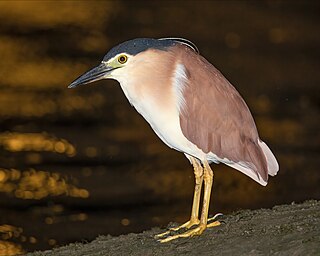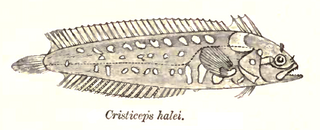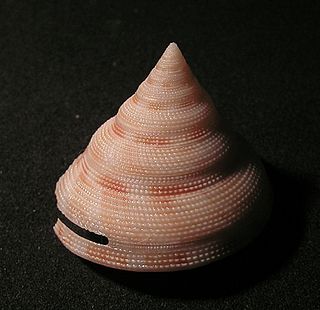
Rosellas are in a genus that consists of six species and nineteen subspecies. These colourful parrots from Australia are in the genus Platycercus. Platycercus means "broad-tailed" or "flat-tailed", reflecting a feature common to the rosellas and other members of the broad-tailed parrot tribe. Their diet is mainly seeds and fruit.

Nycticorax is a genus of night herons. The name Nycticorax means "night raven" and derives from the Ancient Greek nuktos "night" and korax, "raven". It refers to the largely nocturnal feeding habits of this group of birds, and the croaking crow-like call of the best known species, the black-crowned night heron.

The night herons are medium-sized herons, 58–65 cm, in the genera Nycticorax, Nyctanassa, and Gorsachius. The genus name Nycticorax derives from the Greek for “night raven” and refers to the largely nocturnal feeding habits of this group of birds, and the croaking crow-like call of the best known species, the black-crowned night heron.

The nankeen night heron is a heron that belongs to the genus Nycticorax and the family Ardeidae. Due to its distinctive reddish-brown colour, it is also commonly referred to as the rufous night heron. It is primarily nocturnal and is observed in a broad range of habitats, including forests, meadows, shores, reefs, marshes, grasslands, and swamps. The species is 55 to 65 cm in length, with rich cinnamon upperparts and white underparts. The nankeen night heron has a stable population size, and is classified as a species of least concern by the International Union for Conservation of Nature (IUCN).

Hibbertopterus is a genus of eurypterid, a group of extinct aquatic arthropods. Fossils of Hibbertopterus have been discovered in deposits ranging from the Devonian period in Belgium, Scotland and the United States to the Carboniferous period in Scotland, Ireland, the Czech Republic and South Africa. The type species, H. scouleri, was first named as a species of the significantly different Eurypterus by Samuel Hibbert in 1836. The generic name Hibbertopterus, coined more than a century later, combines his name and the Greek word πτερόν (pteron) meaning "wing".

The green rosella or Tasmanian rosella is a species of parrot native to Tasmania and Bass Strait islands. It was described by the German naturalist Johann Friedrich Gmelin in 1788, and named on the mistaken assumption it came from New Caledonia. At 37 cm (14.5 in) long it is the largest species of the rosella genus, Platycercus. Two subspecies are recognised. The green rosella's underparts, neck and head are yellow, with a red band above the beak and violet-blue cheeks. The back is mostly black and green, and its long tail blue and green. The sexes have similar plumage, except the female has duller yellow plumage and more prominent red markings, as well as a smaller beak. Juvenile and immature birds have predominantly green plumage.

The blacktip grouper, also known as the redbanded grouper, blacktipped cod, black-tipped rockcod, footballer cod, red-barred cod, red-barred rockcod, scarlet rock-cod or weathered rock-cod, is a species of marine ray-finned fish, a grouper from the subfamily Epinephelinae which is part of the family Serranidae, which also includes the anthias and sea basses. It is found in the tropical Indo-Pacific region. It is the type species of the genus Epinephelus.

Inimicus is a genus of venomous fishes, closely related to the true stonefishes. This genus is a member of the family Synanceiidae of the ray-finned fish order Scorpaeniformes. These benthic fishes are found on sandy or silty substrates of lagoon and seaward reefs, in coastal regions of tropical oceans. The ten described species are collectively known by various common names, including ghoul, goblinfish, sea goblin, spiny devilfish, stinger, and stingfish).

Mikadotrochus is a genus of sea snails, marine gastropod mollusks in the family Pleurotomariidae, the slit snails.

Bathyfautor is a genus of sea snails, marine gastropod mollusks in the family Calliostomatidae.

Leptotrophon caledonicus is a species of sea snail, a marine gastropod mollusk in the family Muricidae, the murex snails or rock snails.

Springeratus is a genus of clinids found in the southwestern Pacific and western Indian Ocean. The generic name honours the American taxonomist and ichthyologist Victor G. Springer.
Springeratus polyporatus is a species of clinid native to the waters around the Indian Ocean islands of Réunion and Mauritius where it can be found from the surface to 15 metres (49 ft) in depth. It can reach a maximum length of 5 centimetres (2.0 in) SL.

Springeratus xanthosoma is a species of clinid native to coastal areas of the western Pacific and Indian Ocean. It can reach a maximum length of 7 centimetres (2.8 in) TL.

Bathyfautor caledonicus is a species of sea snail, a marine gastropod mollusk in the family Calliostomatidae.

Mikadotrochus caledonicus is a species of large sea snail, a marine gastropod mollusk in the family Pleurotomariidae, the slit snails.

Caprodon is a small genus of fish belonging to the subfamily Anthiinae. It contains three species.

Pseudorhabdosynochus caledonicus is a diplectanid monogenean parasitic on the gills of the Blacktip grouper, Epinephelus fasciatus. It has been described in 2005.
Macrocleptes caledonicus is a species of beetle in the family Cerambycidae. It was described by Stephan von Breuning in 1947.














